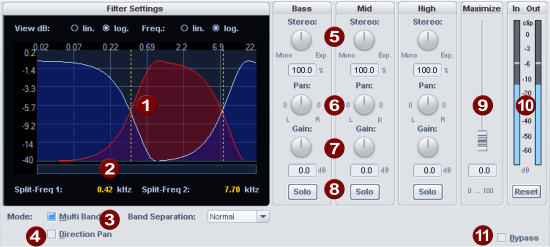Multiband Stereo Enhancer

The Multiband Stereo Enhancer allows manipulation and correction of the stereo image in three independent frequency bands.
|
|
Filter graphic: The graphic shows you the frequency responses of the individual bands. The left axis label displays damping in -dB, the top axis label - frequencies in kHz. The labeling can be either linear or logarithmic |
|
|
Crossover frequencies: Drag the dashed vertical lines to change the crossover frequencies of the three filter bands. The displayed values in kHz correspond to the intersection points of the adjacent frequency curves. Band Separation: This parameter influences different properties of the filters simultaneously, so that the "separation sharpness " increases. With a higher setting for the band separation, the slope of the filter curves increases, i.e. the transition range between two bands becomes smaller and the attenuation in the stop band increases. |
|
|
Multiband: If this is active, the stereo enhancer works in three frequency bands. |
|
|
Direction Pan: Here you can choose between two modes for the operation of the pan controls: If Directional Pan is off, the pan controls operate conventionally. The entire stereo signal is shifted in the panorama. If the mode is active, only the mono part (the center signal) is considered in the panorama adjustment. The panorama control functions as a directional mix controller. A centered vocals recording can thereby later be moved to the left or right of the stereo balance. The difference component (the side signal), which contains the sound sources that are located off center, remains unchanged. |
|
|
Under Bass/Mid/High there are controls for stereo manipulation of the corresponding band: |
|
|
Base width control: Here you set the base width between 0 and 200. 0 means mono, 100 corresponds to unchanged base width (stereo) and a value of 200 means maximum base width (differential signal). Depending on the correlation between left and right, there may be an increase in level when the base width is reduced. In the extreme case of maximum correlation, which occurs when the left and right channels are identical, and a set base width of 0 (mono), a level increase of 3 dB occurs. When the base width is increased (values above 100), the mono compatibility decreases. If, on the other hand, you reduce the base width, mono compatibility is maintained. |
|
|
Panorama controller: Here you set the panorama for the individual bands. Next to the slider the attenuation for left and right is displayed in dB. If the direction pan mode is active, the controllers operate as direction mixers. In this case, only the mono component (mid signal) is taken into account. |
|
|
Gain: Adjusts the level of the respective band. |
|
|
Solo: With Solo the frequency bands can be listened to individually. This option makes it easier to set the filter parameters. As an example, you can isolate a specific frequency range of a mix, and change the aspect of the stereo image for the range. |
|
|
Maximize: This control compresses the side signal, increasing stereo transparency without affecting mono compatibility. In multiband mode, this setting affects the middle band. |
|
|
In/Out: The peak meters show the input and output level in dB. Reset on these displays resets the display of the maximum level of In and Out. |
|
|
Bypass: This allows you to temporarily disable the effect in order to compare the unprocessed signal with the processed signal. |










